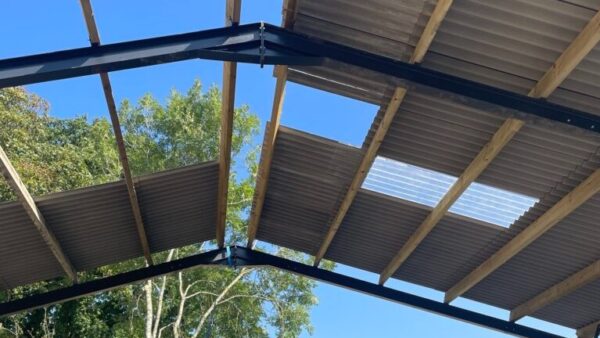D Day 75 – Memories of Mulberry from Wates Group on Vimeo.
Wates Group has unearthed a series of rare images from its archive of its engineers constructing the Mulberry floating docks in time for the 75th anniversary of the D-Day landings.
The Mulberry harbours were instrumental to the D-Day campaign, enabling ships carrying vital supplies, military vehicles and troops to anchor safely off the French coast.

The harbours were designed and built at yards and docks across the country including at Southampton, in Mitcham and the West India Docks in London
They were designed and constructed in secrecy by around 200,000 British engineers in the seven months leading up to the landing in June 1944.
During the second world war, Wates built aerodromes, army camps and factories. Having developed a specialty in precast concrete structures, it also supplied the concrete pier and pierhead pontoons for the Mulberry harbours.

Wates had already gained expertise in pre-cast concrete as part of construction works during the war
The harbours were designed and built at yards and docks across the country including at Southampton, in Mitcham and the West India Docks, before they were assembled at Selsey in Sussex and towed across the channel to Normandy in sections after completion in April 1944.
Wates was among an alliance of British companies that joined forces to build the harbours. Wates was particularly involved in the construction of the concrete piers and pontoons known as ‘Beetles’. While one harbour was destroyed in a storm after just a couple of days, the second was operational for 10 months, making a significant contribution to the Allied war effort. In total, the harbour enabled 2.5 million men, 500,000 vehicles and 4 million tonnes of supplies to land before it was decommissioned.

One harbour was destroyed in a storm but the other remained operation for 10 months
As the international community marks the 75th anniversary of the D-Day landings, Wates has worked with D-Day Revisited – a charity established to commemorate the anniversary – to create a film celebrating the harbours.
The film, titled “Memories of Mulberry”, includes rare photographs from the Wates archives, showing engineers working on the huge concrete and steel parts, as well as insight from leading historian Guy Walters.

The harbour enabled 2.5 million men and 500,000 vehicles
Ted Cordery, 95 and from Oxford, who served on board the Royal Navy’s HMS Belfast from 1943-1944 as a leading seaman torpedoman, is one of two D-Day veterans interviewed for the film about their memories of the historic landings. He said: “When I look back on my career in the Navy, I felt I spent more time fighting the sea than I did the Germans. You could never rely on it. It always turned one way or the other. The harbours minimised the possibility of this and you can’t have a better contribution than that in my opinion.”
Jack Quinn, also 95 and from Mablethorpe, Lincolnshire, who was a corporal in the Royal Marines, added: “We wondered what they were at first, when we saw them. ‘What are they going to do with them? They are going to load men and vehicles on them.’ We were surprised they towed them all that way. But the soldiers were glad to get in a lorry and drive off a Mulberry harbour instead of getting in a landing craft and getting wet through. Speed was the essence.”
Historian and author Guy Walters said: “When you think of inventions during the Second World War you think of the bouncing bomb, you think of radar, but for my money Mulberry harbours are right up there. They’re a classic example of British ingenuity and inventiveness.”
James Wates CBE, chairman of the Wates Group, said: “Wates has a proud history as an innovator in construction, and nowhere is this more evident than our involvement with building the Mulberry harbours. I remember my grandfather [Sir Ronald Wates] speaking to me about them when I was a boy, and I know he was so proud of what we were able to do.
“As we mark the 75th anniversary of the D Day landing, we look back with pride at our role in bringing an end to World War Two, and supporting our armed forces. Our purpose today remains as it was then: to work together to inspire better ways of creating the places, communities and businesses of tomorrow.”
Comments
Comments are closed.











Do you know that the harbours were named after the mulberry tree in the garden of Kingswood School, Bath? The school had been requisitioned in the war and the designers of the harbours looked out of the window and drew inspiration for a name from the mulberry tree in the garden.
What a marvellous achievement and effort.
To deliver that unique project On Time -On Budget – ON Spec was a turning point and a huge contributor to our ultimate Victory.
It makes me very proud to be a British Constructor!!
John Laing & Sons was one of the many contractors involved.
And the record shows that RH Harry Stanger was entrusted with the quality control of materials and fittings for the concrete ‘Phoenix’ units of Mulberry Harbour.
Great piece of engineering and thinking outside the box. Well done Wates and their design teams all those years ago.
My Father, who was a Plasterer (builder) by trade, worked on the building of the Mulberry Harbours He told me about it many years after the war. Alhough we lived in Surrey, he was sent up to Liverpool to do his work.
Is the film by Wates – Memories of Mulberry – Available to buy ?
It was a privileged to work with men, both British and Polish, who had worked on the Mulberry harbours. The shuttering system was adapted by John Mowlem & Co. Ltd to produce the “all fines” system of housing which I was extensively used in the 60’s and 70’s to produce good quality homes. In Stevenage at Pin Green we were handing over thermal efficient homes complete with wall paper and curtain rails at the rate of 38 per week, can any home builder match that today?
Having been a construction manager and more recently a Prof of Construction Management I am keen to hear from those with living memories of the procurement process of the mulberry project and the specifications of the materials used, for research purposes.
Thanks in advance
PS: fantastic archives.